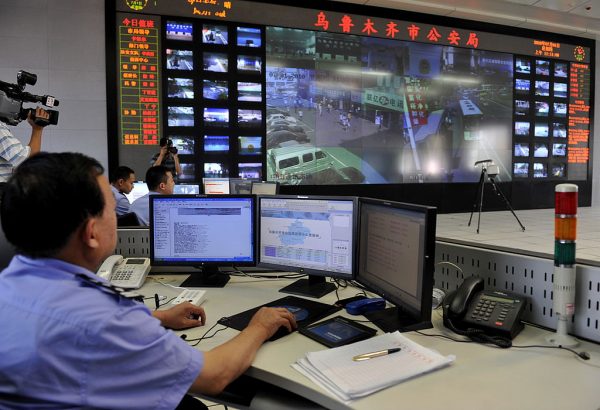The Biden administration’s recent update to former President Donald Trump’s November of 2020 Executive Order restricting companies associated with Beijing’s military quietly removed 16 entities from the grasp of U.S. federal sanctions.
In its original form, Trump’s EO used provisions from a law passed in 1999 targeting “Communist Chinese military companies” to create a blacklist of Chinese firms associated with or operated by the People’s Liberation Army (PLA).
Among those freed from enforcement is the Chinese Communist Party’s (CCP) largest supercomputer manufacturer, a company with ties to U.S.-based industry giants AMD, Nvidia, and Intel. The company also creates surveillance equipment used in the genocide against Uyghurs in Xinjiang along with bleeding edge weapons advancements.
On June 3, Joe Biden signed an Executive Order which did not rescind Trump’s November 12, 2020 EO, but instead overwrote six paragraphs. In the Order, Biden said it was necessary to update the Executive Branch’s instructions in order to address threats “posed by the military-industrial complex of the People’s Republic of China (PRC) and its involvement in military, intelligence, and security research and development programs, and weapons and related equipment production under the PRC’s Military-Civil Fusion strategy.”
The President also specifically noted in his Order, “The use of Chinese surveillance technology outside the PRC and the development or use of Chinese surveillance technology to facilitate repression or serious human rights abuse constitute unusual and extraordinary threats.”
Success
You are now signed up for our newsletter
Success
Check your email to complete sign up
The new EO is curious in that it is careful to remove any phrasing that either used the term “Communist Chinese” or referred to the CCP. For example, the title of the new Order is Addressing the Threat From Securities Investments That Finance Certain Companies of the People’s Republic of China, revised from Addressing the Threat From Securities Investments That Finance Communist Chinese Military Companies, while the title of the blacklist was also updated from the Non-SDN Communist Chinese Military Companies List to the Non-SDN Chinese Military-Industrial Complex Companies List.
The wording of Trump’s Executive Order was not based on anything resembling xenophobia or McCarthyism, however. Instead, it relied on the amended 1999 National Defense Authorization Act (NDAA), which specifically directed the DOD to direct “Communist Chinese military companies” which are “Operating directly or indirectly in the United States or any of its territories and possessions.”
While the FY1999 NDAA required the DOD to complete its work on Communist Chinese military companies by March 1, 2001, this did not happen. The first list created under the Act was completed until June of 2020.
In his Order, Biden not only quietly excluded 16 companies from the list, but also moved the power to add companies to the list from the Department of Defense to the Department of Treasury, stirring fears that Wall Street’s close ties to the CCP may result in a serious conflict of interest in U.S. national security.
One of the most notable companies now excluded from sanctions is Dawning Industry Information Co., otherwise known as Sugon.
‘Military-Civil Fusion’
In a May 27 report by the Foundation for Defense of Democracies (FDD) titled Defusing Military-Civil Fusion, the Washington-based non-profit discusses the CCP’s movement to bind the country’s civil sector with the PLA in a approach to national policy similar to what is used under fascism, describing Military Civil Fusion (MCF) as “tailored for the globalized commercial ecosystem: MCF leverages the international integration of Chinese military companies – both private and state-owned – in order to acquire resources and leverage.”
The report put emphasis on the 44 companies that were assessed by Mike Pompeo’s State Department to be tied to the PLA in the form of “Traditional Chinese defense contractors as well as companies that specialize in information technology (IT), engage in commercial business, and operate in legacy industrial domains.”
“Most are state-owned enterprises. All are state-supported.”
Its research points out that the threat posed by China has already manifested on American soil. Massachusetts Bay Transit Authority purchased railway cars, Michigan-based aerospace firms have been acquired, real estate development is underway in California, and Silicon Valley is being filled with research and development outlets, among several other examples.
The FDD points out in its report, which was published before Biden’s latest move, that the 44 companies on the Pentagon’s blacklist were not an all-inclusive universe of the CCP’s MCF vanguard. Instead, they “represent just the tip of the iceberg.”
The institute recommended the U.S. government, rather than trying to add an ever-expanding group of Chinese companies to its blacklist, instead “adopt a clear prioritization framework to target the companies that matter most.”
The Sugon concern
On June 10, Reps. Jim Banks (R-IN) and Joe Wilson (R-SC), Chairmen of the Republican Study Committee, an alliance of lawmakers who have been vocal in voicing their concerns about the dovish and conciliatory stance the Biden administration has taken against the CCP since coming into power, wrote to Secretaries of Treasury and State Janet Yellen and Lloyd Austin to express their concerns over the removal of the 16 companies from the blacklist.
In specific, Banks and Wilson were worried about Sugon, which Banks described in a November of 2020 letter to the Trump administration’s Secretary of Commerce, Wilbur Ross, as Asia’s largest manufacturer of supercomputers and a “key enabler” of the CCP’s hypersonic glide vehicle and nuclear weapons simulation testing programs.
The duo cited a Washington Post article, which ultimately relied on a November 2020 article by New York Times, describing the Urumqi Cloud Computing Center, an AI-reliant supercomputing center established by the CCP to facilitate the total technocratic surveillance of Uyghurs during its genocide campaign.
NYT lauded the computers in the Center as “among the world’s most powerful,” noting “They can watch more surveillance footage in a day than one person could in a year. They look for faces and patterns of human behavior. They track cars. They monitor phones.”
The article says the reason the CCP has the computing power available at its disposal to create its Orwellian monolith is because U.S.-based industry leaders, Nvidia and Intel, have been feeding their products and intellectual property to the Party since at least 2016.
The authors say Intel and Nvidia have proclaimed they didn’t know about the technology transfer and decried it as a misuse of their technology. However, Nvidia and Intel sold the chips that wound up in the Urumqi oversight facility to Sugon, “the Chinese company backing the center.”

NYT also said the Urumqi facility would host an installation of the Party’s Sharp Eyes project (雪亮 “Xue Liang,” translating literally to “Bright as Snow”) that allows the regime to monitor every aspect of citizens daily life in real time.
“Sugon is an important supplier to Chinese military and security forces, but it also makes computers for ordinary companies,” they add.
The FDD report notes that Sugon, which was established through the Chinese Academy of Sciences (CAS), the company’s largest shareholder, established a formal agreement with the Chinese Institute of Command and Control (CICC) in 2016 to deploy command and control tech in “national defense construction and national security,” while also being praised by Communist Party mouthpiece Xinhua as helping build “the PLA joint combat command system.”
FDD also points out that the CAS is a full-bore participant in the CCP’s Military Civil Fusion project and its creations are regularly paraded during the CICC’s expos.
CAS, which is not a company, but does control investment and operational arms, “sits at the center of China’s R&D ecosystem.” Its business model “rests on foreign cooperation, including with U.S. researchers, on topics ranging from high-energy physics to materials science,” according to FDD.
The AMD precedent
In a 2019 article by the Wall Street Journal titled How a Big U.S. Chip Maker Gave China the ‘Keys to the Kingdom’, the story of how a nearly-bankrupt AMD was brought back to life by capital infusions paid by the CCP in exchange for a joint venture with Sugon was disclosed to the public.
WSJ says in 2014, when AMD was on the verge of destruction and its shares were trading at less than $3, it named a new CEO, Lisa Su, a “Taiwan-born New Yorker” to take the helm. Three weeks before taking the ropes at the struggling chip manufacturer, Su “jetted to Beijing to meet officials at China’s Ministry of Industry and Information Technology.”
The Ministry Su paid a visit to is identified in FDD’s report as being a key Party arm of the MCF initiative, and according to WSJ, its Vice Minister urged her to partner with the regime to “achieve mutual benefits based on AMD’s technological strength.”
In 2016, AMD entered into a joint venture with Sugon to make chips licensing AMD’s x86 technology in exchange for $293 million in licensing fees and royalties on the sale of chips Sugon developed in the venture.
AMD then received a second transfusion of blood from the Communist Party when it was paid $371 million for selling 85 percent of its stake in two semiconductor facilities in Malaysia and China.
Starting in April of 2016, AMD’s value on the NASDAQ began to rocket from a low of $2.79 to a high of $12.42 by the end of the year. Today, the company trades for slightly less than $85, seeing most of its growth from 2019 to present.
The Trump administration attempted to get AMD to submit the deal to the Committee on Foreign Investment in the U.S., but AMD resisted every step of the way, insisting their dealings with the Party were perfectly legal and everything was on the up and up.
WSJ describes the joint venture between AMD and Sugon as a two-part deal. The first, which is AMD controlled, licenses x86 intellectual property and is supposed to manage production of its chips. The second, controlled by Sugon, designs the devices AMD’s chips use and sells the final retail and commercial product.
“The arrangement enables AMD to share technology with China while retaining control over the entity working with its intellectual property. The creation of the second, China-controlled, joint venture allowed the parties to claim that the resulting product was indigenously developed in China, a key goal of the Chinese government,” reads the article.
Sugon’s AMD-inspired chips were named Dhyana and were, according to a person familiar with the deal interviewed by WSJ, created for the purpose of “providing processing technology to Chinese tech giants such as Baidu Inc. or Tencent Holdings Ltd.”
The head of CAS’s computing institute, Sun Ninghui, told a state-run newspaper the purpose of licensing AMD’s tech was to be able to assimilate it into their own product lines, “This gradually advances our ability to comprehend their core technologies.”
“That way, we no longer can be pulled around by our noses,” he said.
The same day the story was published, AMD claimed the WSJ’s reporting contained “several factual errors and omissions and does not portray an accurate picture” of its dealings with the CAS’s Sugon. The company claimed it only supplied legacy versions of its x86 technology, and “put significant protections in place to protect its intellectual property (IP) and prevent valuable IP from being misused or reverse engineered to develop future generations of processors.”
Yet in October of 2020, Tom’s Hardware reported Sugon now had in its possession in addition to its Dhyana product line, Radeon MI50 and MI60 mezzanine cards for high performance computing, which were forbidden from being exported under Trump’s sanctions.







